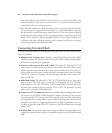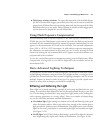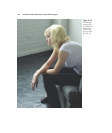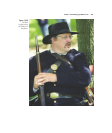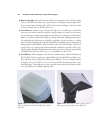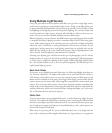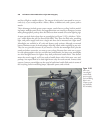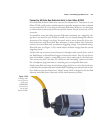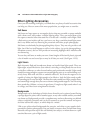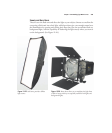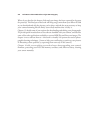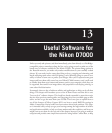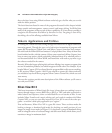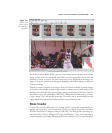Other Lighting Accessories
Once you start working with light, you’ll find there are plenty of useful accessories that
can help you. Here are some of the most popular that you might want to consider.
Soft Boxes
Soft boxes are large square or rectangular devices that may resemble a square umbrella
with a front cover, and produce a similar lighting effect. They can extend from a few
feet square to massive boxes that stand five or six feet tall—virtually a wall of light. With
a flash unit or two inside a soft box, you have a very large, semi-directional light source
that’s very diffuse and very flattering for portraiture and other people photography.
Soft boxes are also handy for photographing shiny objects. They not only provide a soft
light, but if the box itself happens to reflect in the subject (say you’re photographing a
chromium toaster), the box will provide an interesting highlight that’s indistinct and
not distracting.
You can buy soft boxes or make your own. Some lengths of friction-fit plastic pipe and
a lot of muslin cut and sewed just so may be all that you need. (See Figure 12.25.)
Light Stands
Both electronic flash and incandescent lamps can benefit from light stands. These are
lightweight, tripod-like devices (but without a swiveling or tilting head) that can be set
on the floor, tabletops, or other elevated surfaces and positioned as needed. Light stands
should be strong enough to support an external lighting unit, up to and including a rel-
atively heavy flash with soft box or umbrella reflectors. You want the supports to be
capable of raising the lights high enough to be effective. Look for light stands capable
of extending six to seven feet high. The nine-foot units usually have larger, steadier bases,
and extend high enough that you can use them as background supports. You’ll be using
these stands for a lifetime, so invest in good ones. I bought my light stands when I was
in college, and I have been using them for decades.
Backgrounds
Backgrounds can be backdrops of cloth, sheets of muslin you’ve painted yourself using
a sponge dipped in paint, rolls of seamless paper, or any other suitable surface your mind
can dream up. Backgrounds provide a complementary and non-distracting area behind
subjects (especially portraits) and can be lit separately to provide contrast and separa-
tion that outlines the subject, or which helps set a mood.
I like to use plain-colored backgrounds for portraits, and white or gray seamless back-
grounds for product photography. You can usually construct these yourself from cheap
materials and tape them up on the wall behind your subject, or mount them on a pole
stretched between a pair of light stands.
David Busch’s Nikon D7000 Guide to Digital SLR Photography438



